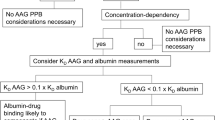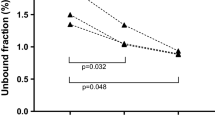Summary
The relationship between the degree of plasma binding of lidocaine (lignocaine) and the concentration of the acute phase reactant, α1-acid glycoprotein (AAG), is reviewed. Studies in normal subjects and patients with myocardial infarction, renal disease, hepatic failure and receiving antiepileptic drug therapy have all shown a remarkably good relationship between AAG concentration and the binding ratio for lidocaine. In situations where AAG is altered, particularly myocardial infarction, the usual therapeutic range for total plasma lidocaine concentrations may not apply and must be interpreted appropriately. This provides the strongest rationale for monitoring free rather than total drug concentration as an aid in lidocaine therapy.
Similar content being viewed by others
References
Bachmann, G.W.; Weiss, M.E. and Rapp, W.: Differenzierte quantitative Serumeiweissbestimmungen im Ablauf des Herzinfaktes. Schweizerische Medizinische Wochenschrift 46: 1825–1829 (1968).
Barchowsky, A.; Shand, D.G.; Starge, W.W.; Wagner, G.S. and Routledge, P.A.: On the role of a alpha-1-acid glycoprotein in lignocaine accumulation following myocardial infarction. British Journal of Clinical Pharmacology 13: 411–415 (1982).
Borgå, O.; Piafsky, K.M. and Nielsen, O.G.: Plasma protein binding of basic drugs. I. Selective displacement from alpha-1-acid glycoprotein by trist (2-butosyethyl) phosphate. Clinical Pharmacology and Therapeutics 22: 539–544 (1977).
Brown, J.E.; Kitchell, B.B.; Bjornsson, J.D. and Shand, D.B.: The artifactual nature of heparin-induced drug protein binding alteration. Clinical Pharmacology and Therapeutics 30: 636–643 (1981).
Buckman, K.; Clairborne, K.; deGuzman, M.; Walberg, C.B. and Haywood, L.J.: Lidocaine efficacy and toxicity assessed by a new, rapid method. Clinical Pharmacology and Therapeutics 28: 177–181 (1980).
Cotham, R.H. and Shand, D.G.: Spuriously low plasma propranolol concentrations resulting from blood collection methods. Clinical Pharmacology and Therapeutics 18: 535–538 (1975).
Davis, D.; Grossman, S.H.; Kilchell, B.B., Shand, D.G. and Routledge, P.A.: Age-related changes in the plasma protein binding of lidocaine and diazepam. Clinical Research 28: 234A (1980).
Deglin, S.M.; Deglin, J.M., Wurtzbacher, T.; Litton, M.; Rolfe, C. and Mclntyre, C: Rapid serum lidocaine determination in the coronary care unit. Journal of the American Medical Association 244: 571–573 (1980).
Giacomini, K.M.; Swezcy, S.E.; Giacomini, J.C. and Blaschke, T.F.: Administration of heparin causes in vitro release of non-esterified fatty acids in human plasma. Life Sciences 27: 771–780 (1980).
Gianelly, R.; Von der Groeben, J.O.; Spivack, A.P. and Harrison, D.C.: Effect of lidocaine on ventricular arrhythmias in patients with coronary heart disease. New England Journal of Medicine 277: 1215–1219 (1967).
Grossman, S.H.; Davis, D.; Kitchell, B.B.; Shand, D.G. and Routledge, P.A.: Diazepam and lidocaine plasma binding in renal disease. Clinical Pharmacology and Therapeutics 31: 350–357 (1982).
Huet, P.M.; Arsene, D. and Richer, G.: The volume of distribution of lidocaine in chronic hepatitis: Relationship with serum glycoprotein and serum protein binding. Clinical Pharmacology and Therapeutics 29: 252–253 (1981).
Johansson, B.D.; Kindmark, CO.; Trell, E.Y. and Wollheim, F.A.: Sequential changes of plasma proteins after myocardial infarction. Scandinavian Journal of Clinical and Laboratory Investigation 29 (Suppl. 124): 117–126 (1972).
Koch-Weser, J. and Sellers, E.M.: Binding of drugs to serum albumin. New England Journal of Medicine 294: 311–316 (1976).
LeLorier, J.; Grenon, D.; Latour, Y.; Caille, G.; Dumont, G.; Brousseau, A. and Solignac, A.: Pharmacokinetics of lidocaine after prolonged infusions in uncomplicated myocardial infarction. Annals of Internal Medicine 87: 700–702 (1977).
McGowan, F.X.; Reiter, M.J.; Pritchett, E.L.C. and Shand, D.G.: Verapamil plasma binding: Relationship to alpha-1-acid glycoprotein and drug efficacy. Clinical Pharmacology and Therapeutics 33: 485–490 (1983).
Noneman, J.W. and Rogers, J.F.: Lidocaine prophylaxis in acute myocardial infarction. Medicine (Baltimore) 57: 501–515 (1978).
Piafsky, K.M. and Borgå, O.: Plasma protein binding of basic drugs. II. Importance of alpha-1-acid glycoprotein for interindividual variation. Clinical Pharmacology and Therapeutics 22: 545–549 (1977).
Piafsky, K.M. and Knoppert, D.: Binding of local anesthetics to alpha-l-acid glycoprotein. Clinical Research 26: 836A (1978).
Piafsky, D.M. and Mpamugo, L.: Dependence of neonatal drug binding on alpha-l-acid glycoprotein. Clinical Pharmacology and Therapeutics 29: 272 (1981).
Pieper, J.A.; Wyman, M.G.; Goldreyer, B.N.; Cannom, D.S.; Slaughter, R.L. and Lalka, D.: Lidocaine toxicity: Effects of total versus free lidocaine concentrations. Circulation 62 (Suppl. 3): 111–181 (1980).
Prescott, L.F.; Adjepom-Yamoah, K.K. and Talbot, R.G.: Impaired lignocaine metabolism in patients with myocardial infarction and heart failure. British Medical Journal 1: 939–941 (1976).
Routledge, P.A.; Barchowsky, A.; Bjornsson, T.D.; Kitchell, B.B. and Shand, D.G.: Lidocaine plasma protein binding. Clinical Pharmacology and Therapeutics 271: 347–351 (1980a).
Routledge, P.A.; Stargel, W.W.; Wagner, G.S. and Shand, D.G.: Increased alpha-l acid giycoprotein and lidocaine disposition in myocardial infarction. Annals of Internal Medicine 93: 701–704 (1980b).
Routledge, P.A.; Stargel, W.W.; Finn, A.L.; Barchowsky, A. and Shand, D.G.: Lignocaine disposition in blood in epilepsy. British Journal of Clinical Pharmacology 12: 663–666 (1981a).
Routledge, P.A.; Shand, D.G.; Barchowsky, A.; Wagner, G. and Stargel, W.W.: Relationship between alpha-acid glycoprotein and lidocaine disposition in myocardial infarction. Clinical Pharmacology and Therapeutics 30: 154–157 (1981b).
Routledge, P.A.; Stargel, W.W.; Kitchell, B.B.; Barchowsky, A. and Shand, D.G.: Sex-related differences in the plasma protein binding of lignocaine and diazepam. British Journal of Clinical Pharmacology 11: 245–250 (1981c).
Routledge, P.A.; Stargel, W.W.; Barchowsky, A.; Wagner, G.S. and Shand, D.G.: Control of lidocaine therapy: New perspectives. Therapeutic Drug Monitoring 4: 265–270 (1982).
Sawinski, V.J. and Rapp, G.W.: Interaction of human serum proteins with local anesthetic agents. Journal of Dental Research 42: 1429–1438 (1963).
Shand, D.G.; Pritchett, E.L.C.; Hammill, S.C.; Stargel, W.W. and Wagner, G.S.: Pharmacokinetic studies: Their role in determining therapeutic efficacy of agents designed to prevent sudden death. Annals of the New York Academy of Sciences 382: 238–246 (1982).
Shand, D.G.; Routledge, P.A.; Stargel, W.W. and Wagner, G.S.: ‘Free lidocaine index’ as a guide to unbound drug concentration. Clinical Pharmacology and Therapeutics 29: 282–283 (1981).
Stargel, W.W.; Roe, C.R.; Routledge, P.A. and Shand, D.G.: Importance of blood collection tubes in plasma lidocaine determinations. Clinical Chemistry 25: 617–619 (1979).
Stargel, W.W.; Shand, D.G.; Routledge, P.A.; Barchowsky, A. and Wagner, G.: Clinical comparison of rapid infusion and multiple injection methods for lidocaine loading. American Heart Journal 102: 872–876 (1981).
Tucker, G.T.; Boyes, R.N.; Bridenbaugh, P.O. and Moore, D.C.: Binding of anilide-type local anesthetics in human plasma. I. Relationships between binding, physiochemical properties and anesthetic activity. Anesthesiology 33: 287–303 (1970).
Wood, M. and Wood, A.J.J.: Changes in plasma drug binding and alpha-l-acid glycoprotein in mother and newborn infant. Clinical Pharmacology and Therapeutics 29: 522–526 (1981).
Author information
Authors and Affiliations
Rights and permissions
About this article
Cite this article
Shand, D.G. α1-Acid Glycoprotein and Plasma Lidocaine Binding. Clin Pharmacokinet 9 (Suppl 1), 27–31 (1984). https://doi.org/10.2165/00003088-198400091-00004
Published:
Issue Date:
DOI: https://doi.org/10.2165/00003088-198400091-00004




